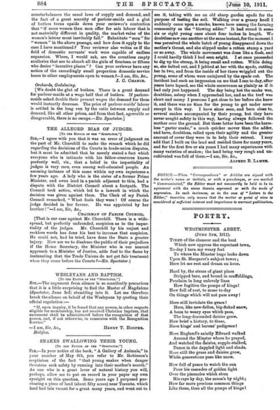SNAKES SWALLOWING THEIR YOUNG.
[TO THE EDITOR OP THE "SPECTATOR,"]
SIE,—In your notice of the book, "A Gallery of Animals," in our number of May 6th, you refer to Mr. Robinson's scepticism of the fact "that young snakes when danger threatens seek safety by running into their mother's mouth." As one who is a great lover of natural history you will, perhaps, allow me to put on record in your paper my own eyesight on this question. Some years ago I purposed pur- chasing a piece of land (about fifty acres) near Toronto, which land had lain vacant for a great many years, and went out to see it, taking with me an old sharp garden spade for the purpose of testing the soil. Walking over a grassy knoll I suddenly came upon a snake, known here among the farming community as the "blowing adder." It had round it some six or eight yeting ones about four inches in length. We doubtless saw one another at the same instant, for the moment I was peroeived the whole batch of young disappeared down the mother's throat, and she slipped under a rotten stump a yard or so away. The whole movement was done like a flash, and I could hardly think I had seen aright. I at once proceeded to dig up the stump, it being small and rotten. While doing so, she bolted out, and I jabbed at her with the spade, cutting her in two, and from the inside of her there wriggled out the young, some of whom were uninjured by the spade cut. The incident had such an impression on me that loan to-day, after years have lapsed, see the whole occurrence as plainly as if it had only just happened. The day being hot the snake was, doubtless, asleep when I approached her, and as the turf was short and mossy I presume I got close to her before she knew it, and there was no time for the young to get under cover except in this way. I have since seen, and been close to, several snakes accompanied by their young, but they have never sought safety in this way, having always followed tho mother over the ground. But these latter have been the harm- less "garter snake," a much quicker mover than the adder, and have, doubtless, relied upon their agility and the greater amount of cover they were in to help their retreat. I may add that I built on the land and resided there for many years, and for the first five or six years I had many experiences with many varieties of snakes; the land being very rough and un- cultivated was full of them.—I am, Sir, &c.,
ALFRED B. LAMSN.










































 Previous page
Previous page